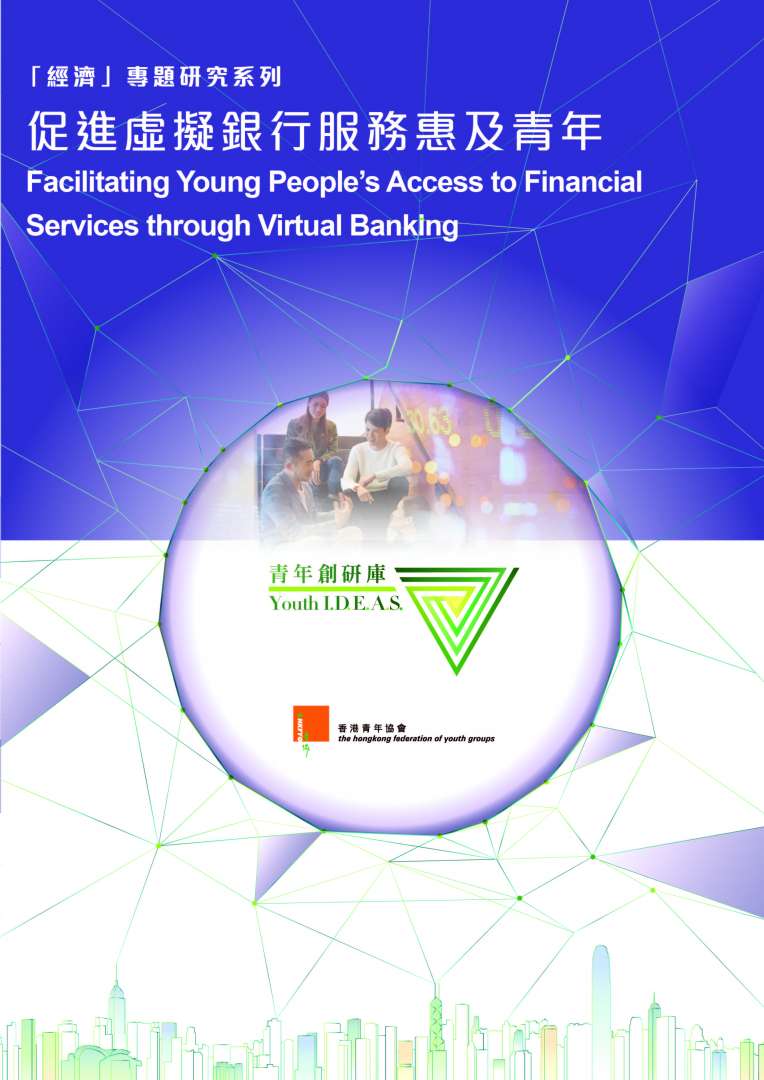Facilitating Young People’s Access to Financial Services through Virtual Banking
Youth I.D.E.A.S. 51
Economic Development
Facilitating Young People’s Access to Financial Services through Virtual Banking
3 July 2020
 According to a Business Insider research service report, the total value of all the world’s virtual banks equalled USD 18.6 billion in 2018, with 26 million users and 50 million accounts. It is expected that the growth of virtual banks is rapid and the total value will increase to USD 63 billion in 2024, with 98 million users and 187 million accounts[1].
According to a Business Insider research service report, the total value of all the world’s virtual banks equalled USD 18.6 billion in 2018, with 26 million users and 50 million accounts. It is expected that the growth of virtual banks is rapid and the total value will increase to USD 63 billion in 2024, with 98 million users and 187 million accounts[1].
The Hong Kong Monetary Authority published a revised set of guidelines on the authorisation of virtual banks in 2018. Its objective is to promote financial inclusion by encouraging FinTech and innovation in Hong Kong and to offer a new kind of customer experience. The Authority issued 8 virtual bank licences last year. Two of them have already started to operate, whilst the rest are expected to launch soon[2]. This will greatly impact the ecology of the financial service industry in Hong Kong.
“Virtual banks” are banks that primarily deliver retail banking services through the internet or other forms of electronic channels instead of physical branches. Their clients include both individuals and small- and medium-sized enterprises (SMEs)[3]. It is expected that the development of FinTech in Hong Kong can be enhanced through virtual banks. The cost of operating virtual banks can be much lower since they do not have physical branches. They can also operate around the clock for the convenience of customers. Therefore, virtual banks have greater incentives to provide services to people with low assets and low incomes and to SMEs, such as convenient small loans, which helps to facilitate economic diversification and, ultimately, to achieve financial inclusion.
The media has reported cases of SMEs encountering difficulties in opening accounts and applying for loans in banks with physical branches[4]. Virtual banks should have greater incentives to provide services to those who are usually overlooked by large banks, including young people who have recently entered the workforce and young entrepreneurs. Besides, virtual banks are more welcomed by generations X, Y and Z[5] than traditional banks[6]. However, whether virtual banks’ services can benefit the younger generation still depends on the success of their businesses and whether their services can respond to young people’s specific needs.
In view of this, this study aims to look at the bank service requirements of young active bank users and business operators (the main client group of virtual banks) as well as their confidence in and worries regarding virtual banking. Firstly, it tries to understand these aspects through an on-site youth survey. Secondly, it tries to understand the specific situations and common problems they encounter with bank services through in-depth interviews with young active bank users and business operators. Thirdly, it tries to understand the advantages and disadvantages of the development of virtual banks in Hong Kong as well as the challenges they face through expert interviews. By synthesising these analyses and information, it is hoped that feasible recommendations can be made to facilitate young people’s access to financial services through virtual banking and to respond to the needs of young people.
This study uses data collected by three methods during the period from April to May 2020: an on-site survey of 525 young people aged 18-39, case interviews with 20 young active bank users and business operators aged 18-39, and interviews with five experts and related parties.
Discussion
- The rise of mobile networks and changes in users’ behaviours in recent years provide a mature environment for the development of virtual banks. All virtual banks in Europe, America and Mainland China target clients overlooked by large banks such as medium-, small-sized and mini enterprises, low asset clients and young people, so that more people can access financial services. Among them, the virtual banks in Mainland China have turned out to be the most successful with their huge customer base.
- The service of physical banks is not able to satisfy the financial needs of Hong Kong young people. Reasons for this include: denial of access to certain services due to low balances, high minimum thresholds for investment products, difficulty getting small loans for individuals and start-ups, bad experiences with online services, etc.
- The emergence of virtual banks is expected to offer more choice of bank service to SMEs, young people who run start-ups and low asset customers in order to attain financial inclusion. Experts generally agree that virtual banks can provide a more convenient channel for opening accounts, deposits, investment and credit. But the public is still worried about the misuse of privacy. The conservative commercial environment is also detrimental to the development of virtual banks.
- Electronic banking and non-physical transaction channels are generally accepted by young people. They are well prepared to use virtual banking services. However, how much younger groups and people with lower assets and lower educational attainment can be benefited from electronic banking services depends on service coverage and the method of implementation.
- More than 60% of the young respondents think that the main benefit of virtual banking is that it is “fast”, which they also feel is the most important element of bank services. However, they are still worried enough about network security, privacy protection and bank stability that their confidence is low at the present stage.
- Virtual banks need to provide services to match the daily operational needs of enterprises and to solve the problems generated by incomplete commercial services so that enterprises are able to experience their convenience. Examples include cheque and cash deposits and cash withdrawals as well as complete transaction records.
Recommendations
- The Hong Kong Monetary Authority and the Privacy Commissioner for Personal Data should strengthen public education about personal privacy protection.
- Virtual banks should provide personalised and intelligent self-help financial analyses and recommendations to clients. Regulatory bodies for investment should also study ways to allow virtual platforms to provide such services.
- Virtual banks should provide discounts to encourage merchants to try electronic payment services. They could also provide channels for cash and cheque deposits during the transitional period from cash to non-cash transactions.
- Virtual banks should develop accounting systems that match the daily operational needs of SMEs as well as provide complete electronic transaction records.
[1] Business Insider. (2019). “The Global Neobanks Report: How 26 upstarts are winning customers and pivoting from hyper-growth to profitability in a $27 billion market.” Retrieved March 2, 2020, from https://www.businessinsider.com/global-neobanks-report
[2] HKMA. (March 27, 2019). “Virtual bank licences issued.” Retrieved from https://www.hkma.gov.hk/media/chi/doc/key-information/speeches/s20190327c1.pdf
[3] HKMA. (2020). “Virtual banks.” Retrieved February 26, 2020 from https://www.hkma.gov.hk/eng/key-functions/banking/banking-regulatory-and-supervisory-regime/virtual-banks/
[4] On.cc. (April 8, 2019). “Improvements in opening accounts but loans are still difficult.” Retrieved June 29, 2019, from https://orientaldaily.on.cc/cnt/finance/20190408/mobile/odn-20190408-0408_00202_033.html
[5] Generations X, Y and Z represent those who were born in 1965-76, 1977-94 and 1995-2004, respectively.
[6] J.D. Power. (2019). “In direct bank gold rush, top performers find different paths to success, J.D. Power Finds.” Retrieved March 2, 2020, from https://www.jdpower.com/business/press-releases/2019-direct-banking-satisfaction-study




